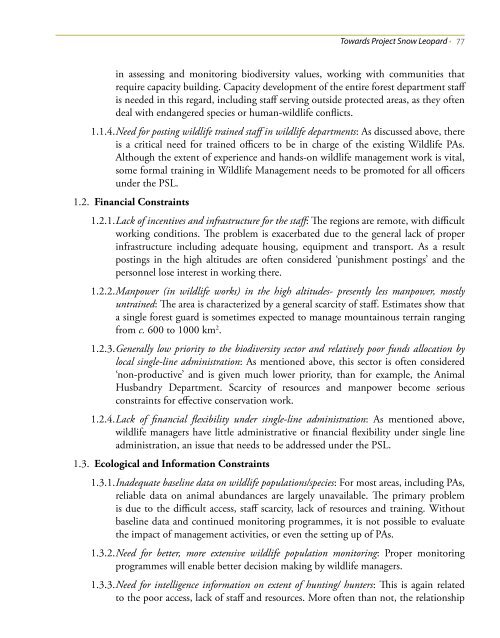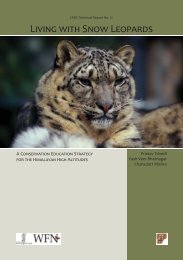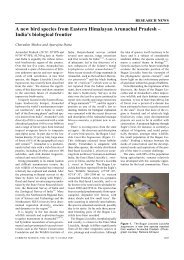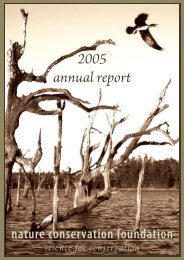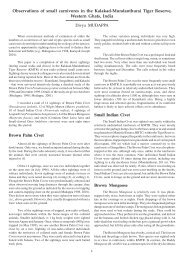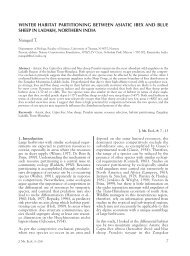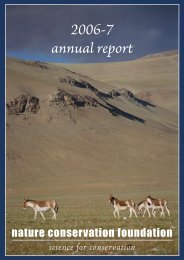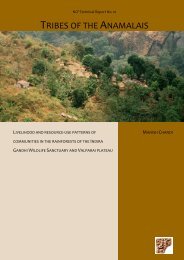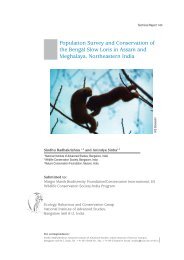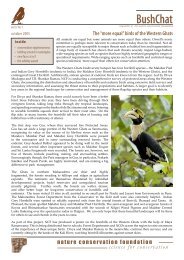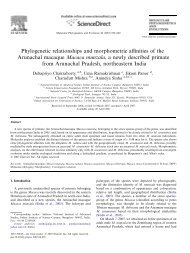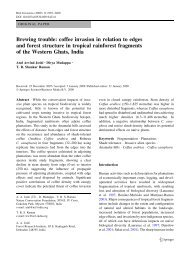towards project snow leopard - Nature Conservation Foundation
towards project snow leopard - Nature Conservation Foundation
towards project snow leopard - Nature Conservation Foundation
Create successful ePaper yourself
Turn your PDF publications into a flip-book with our unique Google optimized e-Paper software.
Towards Project Snow Leopard • 77<br />
in assessing and monitoring biodiversity values, working with communities that<br />
require capacity building. Capacity development of the entire forest department staff<br />
is needed in this regard, including staff serving outside protected areas, as they often<br />
deal with endangered species or human-wildlife conflicts.<br />
1.1.4. Need for posting wildlife trained staff in wildlife departments: As discussed above, there<br />
is a critical need for trained officers to be in charge of the existing Wildlife PAs.<br />
Although the extent of experience and hands-on wildlife management work is vital,<br />
some formal training in Wildlife Management needs to be promoted for all officers<br />
under the PSL.<br />
1.2. Financial Constraints<br />
1.2.1. Lack of incentives and infrastructure for the staff: The regions are remote, with difficult<br />
working conditions. The problem is exacerbated due to the general lack of proper<br />
infrastructure including adequate housing, equipment and transport. As a result<br />
postings in the high altitudes are often considered ‘punishment postings’ and the<br />
personnel lose interest in working there.<br />
1.2.2. Manpower (in wildlife works) in the high altitudes- presently less manpower, mostly<br />
untrained: The area is characterized by a general scarcity of staff. Estimates show that<br />
a single forest guard is sometimes expected to manage mountainous terrain ranging<br />
from c. 600 to 1000 km 2 .<br />
1.2.3. Generally low priority to the biodiversity sector and relatively poor funds allocation by<br />
local single-line administration: As mentioned above, this sector is often considered<br />
‘non-productive’ and is given much lower priority, than for example, the Animal<br />
Husbandry Department. Scarcity of resources and manpower become serious<br />
constraints for effective conservation work.<br />
1.2.4. Lack of financial flexibility under single-line administration: As mentioned above,<br />
wildlife managers have little administrative or financial flexibility under single line<br />
administration, an issue that needs to be addressed under the PSL.<br />
1.3. Ecological and Information Constraints<br />
1.3.1. Inadequate baseline data on wildlife populations/species: For most areas, including PAs,<br />
reliable data on animal abundances are largely unavailable. The primary problem<br />
is due to the difficult access, staff scarcity, lack of resources and training. Without<br />
baseline data and continued monitoring programmes, it is not possible to evaluate<br />
the impact of management activities, or even the setting up of PAs.<br />
1.3.2. Need for better, more extensive wildlife population monitoring: Proper monitoring<br />
programmes will enable better decision making by wildlife managers.<br />
1.3.3. Need for intelligence information on extent of hunting/ hunters: This is again related<br />
to the poor access, lack of staff and resources. More often than not, the relationship


